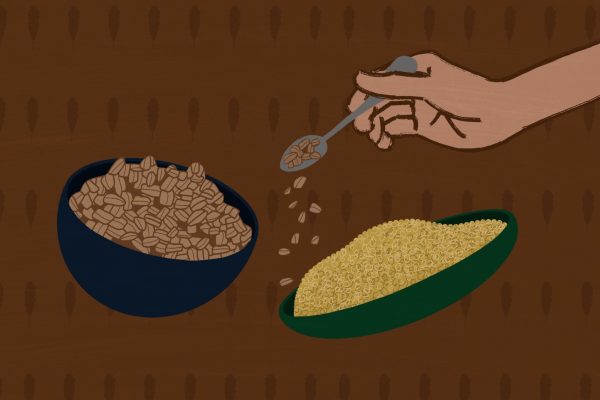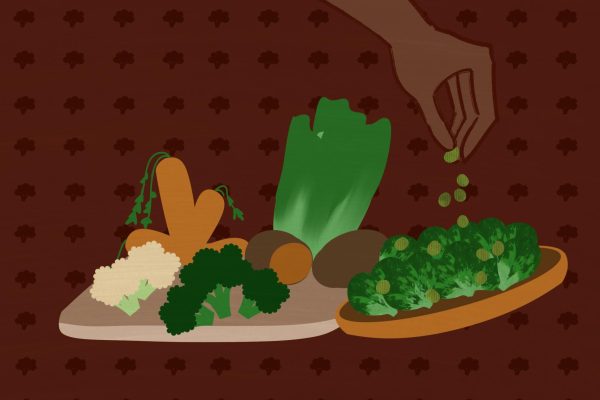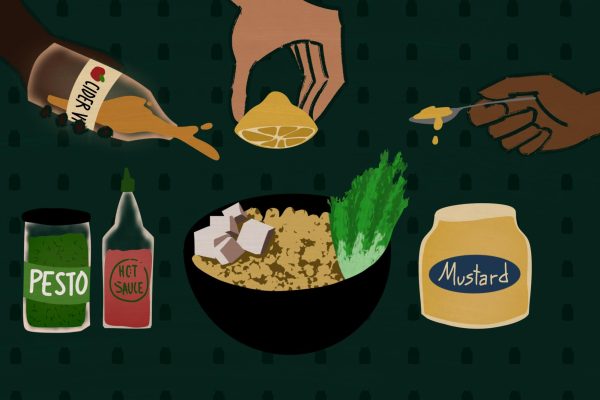Going off of the meal plan this year has meant a lot of trial and error in my kitchen, and coming up with new recipe ideas that don’t require much time or complicated culinary knowledge can be a challenge. But after some experimentation, the hearty grain bowl has become a staple for me.
Grain bowls are not only healthy, filling and customizable, but can also be made quickly, especially when it can be made ahead of time. Instead of heading to DIG or Sweetgreen, you can prepare these bowls for class or for when you get home, which will save you some money. Once you master these steps, you’ll have a hearty stock of food in your dorm-room fridge and a happy belly.
Ancient grains for the win

There are a plethora of ancient grains that can be used as the base for your bowl. My favorites are farro for its thick texture and nuttiness, and quinoa since it’s fluffy and great for absorbing flavor. Ancient grains have been cultivated for thousands of years and, unlike modern wheat, lack genetically modified organisms. Additionally, they are unrefined which means they tend to be higher in protein, B vitamins, omega-3 fatty acids, zinc and fiber.
Choose a vegetable, or two, or three

Let’s face it: vegetables get a bad reputation. It is about time to rewrite that narrative, not only for health reasons but also because vegetables can taste amazing when you cook them right.
Crispy air fryer brussel sprouts with toasted pistachios, sauteed broccoli flavored with soy sauce and sesame seeds, baked cauliflower sprinkled with fajita seasoning — these are all delicious while still packing loads of vitamins into a satisfying meal. Uncooked vegetables, like crunchy carrots or leafy greens, can also add a great texture and extra freshness to your bowl. Say goodbye to bland, soggy, boiled veggies of the past and hello to a whole new world of vegetable bliss.
Protein, protein, protein

As a vegetarian, I often hear that I must not be getting enough protein in my body, but in reality, protein can be found in much more than just meat. My go-to ingredients are tofu and the lesser-known tempeh. Both provide distinct flavor profiles but are also great at soaking up different flavorings. Marinating tofu and tempeh in, for example, a mix of soy sauce, sesame oil and maple syrup can make your bowl much more tasty. If you add cornstarch before cooking, it’ll give a crispy finish.
Nuts are also a great option to add some zest to your creation, and I especially love toasting them to bring out a richer flavor profile. Different legumes such as chickpeas and white beans can also do the trick; sauteed they give a warm nourishing feel, whereas baking them for longer can result in satisfying crunchiness. For the carnivores out there, don’t fear: roast chicken or pan-fried beef could also work, which you can buy frozen for convenience and affordability.
In praise of sauce

Grain bowls are nutritional power houses, but being healthy at the cost of not enjoying what you’re eating isn’t always worth it. There may be articles online or wellness coaches in Los Angeles who advise you to hold the salad dressing, but personally I disagree. To elevate a grain bowl from good to great, a well-made sauce is absolutely necessary.
Apple cider vinegar with dijon mustard and lemon juice adds an acidic tang, tahini mixed with hot sauce and water gives a fiery kick, and pesto and melted feta creates a creamy and indulgent texture. Making these dressings at home can be a great way to steer clear of unnecessary sugars and preservatives. You can also experiment with unlikely combinations that you think will be tasty or remake your favorite Cava or Sweetgreen dressing at home. That said, if you’re pressed for time, grocery stores are stocked with pre-made options that can add instant flare to your grain bowl.
Add something sweet

With all the savory components thrown into the grain bowl, the addition of a sweeter ingredient can play a great supporting role. Including fruits into your bowls is one of the best ways to do this, especially since they offer many of the same health benefits of vegetables.
Crispy apple slices and pre-cooked beets are my favorite right now, but tart blueberries, juicy pears and tangy mangos are also available to jazz things up. While fruit thrown in with more savory flavors might feel like a strange mix, the combination of sweet and salty proves surprisingly satisfactory. Dried fruit such as cranberries or frozen fruit are great too, and there is no need to worry about them going bad in your fridge.
Contact Josie Leach at [email protected].























































































































































